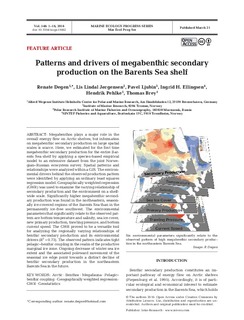| dc.contributor.author | Degen, Renate | |
| dc.contributor.author | Jørgensen, Lis Lindal | |
| dc.contributor.author | Ljubin, Pavel | |
| dc.contributor.author | Ellingsen, Ingrid H. | |
| dc.contributor.author | Pehlke, Hendrik | |
| dc.contributor.author | Brey, Thomas | |
| dc.date.accessioned | 2016-08-08T12:16:08Z | |
| dc.date.accessioned | 2016-08-09T10:19:07Z | |
| dc.date.available | 2016-08-08T12:16:08Z | |
| dc.date.available | 2016-08-09T10:19:07Z | |
| dc.date.issued | 2016-03-21 | |
| dc.identifier.citation | Degen R, Jørgensen LL, Ljubin P, Ellingsen IH, Pehlke H, Brey T (2016) Patterns and drivers of megabenthic secondary production on the Barents Sea shelf. Mar Ecol Prog Ser 546:1-16 | nb_NO |
| dc.identifier.issn | 0171-8630 | |
| dc.identifier.uri | http://hdl.handle.net/11250/2398344 | |
| dc.description | - | nb_NO |
| dc.description.abstract | Megabenthos plays a major role in the overall energy flow on Arctic shelves, but information on megabenthic secondary production on large spatial scales is scarce. Here, we estimated for the first time megabenthic secondary production for the entire Barents Sea shelf by applying a species-based empirical model to an extensive dataset from the joint Norwegian-Russian ecosystem survey. Spatial patterns and relationships were analyzed within a GIS. The environmental drivers behind the observed production pattern were identified by applying an ordinary least squares regression model. Geographically weighted regression (GWR) was used to examine the varying relationship of secondary production and the environment on a shelf-wide scale. Significantly higher megabenthic secondary production was found in the northeastern, seasonally ice-covered regions of the Barents Sea than in the permanently ice-free southwest. The environmental parameters that significantly relate to the observed pattern are bottom temperature and salinity, sea ice cover, new primary production, trawling pressure, and bottom current speed. The GWR proved to be a versatile tool for analyzing the regionally varying relationships of benthic secondary production and its environmental drivers (R2 = 0.73). The observed pattern indicates tight pelagic-benthic coupling in the realm of the productive marginal ice zone. Ongoing decrease of winter sea ice extent and the associated poleward movement of the seasonal ice edge point towards a distinct decline of benthic secondary production in the northeastern Barents Sea in the future. | nb_NO |
| dc.language.iso | eng | nb_NO |
| dc.publisher | Inter-Research | nb_NO |
| dc.rights | Navngivelse 3.0 Norge | * |
| dc.rights.uri | http://creativecommons.org/licenses/by/3.0/no/ | * |
| dc.title | Patterns and drivers of megabenthic secondary production on the Barents Sea shelf | nb_NO |
| dc.type | Journal article | nb_NO |
| dc.type | Peer reviewed | nb_NO |
| dc.date.updated | 2016-08-08T12:16:08Z | |
| dc.source.pagenumber | 1-16 | nb_NO |
| dc.source.volume | 546 | nb_NO |
| dc.source.journal | Marine Ecology Progress Series | nb_NO |
| dc.identifier.doi | 10.3354/meps11662 | |
| dc.identifier.cristin | 1362590 | |

